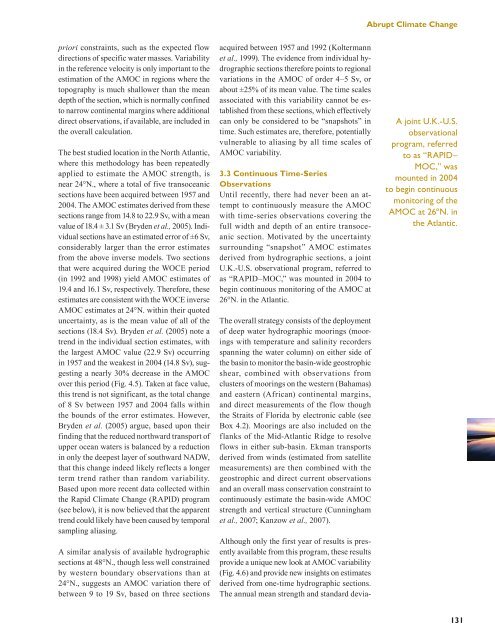Book 2.indb - US Climate Change Science Program
Book 2.indb - US Climate Change Science Program
Book 2.indb - US Climate Change Science Program
- No tags were found...
Create successful ePaper yourself
Turn your PDF publications into a flip-book with our unique Google optimized e-Paper software.
Abrupt <strong>Climate</strong> <strong>Change</strong>priori constraints, such as the expected flowdirections of specific water masses. Variabilityin the reference velocity is only important to theestimation of the AMOC in regions where thetopography is much shallower than the meandepth of the section, which is normally confinedto narrow continental margins where additionaldirect observations, if available, are included inthe overall calculation.The best studied location in the North Atlantic,where this methodology has been repeatedlyapplied to estimate the AMOC strength, isnear 24°N., where a total of five transoceanicsections have been acquired between 1957 and2004. The AMOC estimates derived from thesesections range from 14.8 to 22.9 Sv, with a meanvalue of 18.4 ± 3.1 Sv (Bryden et al., 2005). Individualsections have an estimated error of ±6 Sv,considerably larger than the error estimatesfrom the above inverse models. Two sectionsthat were acquired during the WOCE period(in 1992 and 1998) yield AMOC estimates of19.4 and 16.1 Sv, respectively. Therefore, theseestimates are consistent with the WOCE inverseAMOC estimates at 24°N. within their quoteduncertainty, as is the mean value of all of thesections (18.4 Sv). Bryden et al. (2005) note atrend in the individual section estimates, withthe largest AMOC value (22.9 Sv) occurringin 1957 and the weakest in 2004 (14.8 Sv), suggestinga nearly 30% decrease in the AMOCover this period (Fig. 4.5). Taken at face value,this trend is not significant, as the total changeof 8 Sv between 1957 and 2004 falls withinthe bounds of the error estimates. However,Bryden et al. (2005) argue, based upon theirfinding that the reduced northward transport ofupper ocean waters is balanced by a reductionin only the deepest layer of southward NADW,that this change indeed likely reflects a longerterm trend rather than random variability.Based upon more recent data collected withinthe Rapid <strong>Climate</strong> <strong>Change</strong> (RAPID) program(see below), it is now believed that the apparenttrend could likely have been caused by temporalsampling aliasing.A similar analysis of available hydrographicsections at 48°N., though less well constrainedby western boundary observations than at24°N., suggests an AMOC variation there ofbetween 9 to 19 Sv, based on three sectionsacquired between 1957 and 1992 (Koltermannet al., 1999). The evidence from individual hydrographicsections therefore points to regionalvariations in the AMOC of order 4–5 Sv, orabout ±25% of its mean value. The time scalesassociated with this variability cannot be establishedfrom these sections, which effectivelycan only be considered to be “snapshots” intime. Such estimates are, therefore, potentiallyvulnerable to aliasing by all time scales ofAMOC variability.3.3 Continuous Time-SeriesObservationsUntil recently, there had never been an attemptto continuously measure the AMOCwith time-series observations covering thefull width and depth of an entire transoceanicsection. Motivated by the uncertaintysurrounding “snapshot” AMOC estimatesderived from hydrographic sections, a jointU.K.-U.S. observational program, referred toas “RAPID–MOC,” was mounted in 2004 tobegin continuous monitoring of the AMOC at26°N. in the Atlantic.The overall strategy consists of the deploymentof deep water hydrographic moorings (mooringswith temperature and salinity recordersspanning the water column) on either side ofthe basin to monitor the basin-wide geostrophicshear, combined with observations fromclusters of moorings on the western (Bahamas)and eastern (African) continental margins,and direct measurements of the flow thoughthe Straits of Florida by electronic cable (seeBox 4.2). Moorings are also included on theflanks of the Mid-Atlantic Ridge to resolveflows in either sub-basin. Ekman transportsderived from winds (estimated from satellitemeasurements) are then combined with thegeostrophic and direct current observationsand an overall mass conservation constraint tocontinuously estimate the basin-wide AMOCstrength and vertical structure (Cunninghamet al., 2007; Kanzow et al., 2007).Although only the first year of results is presentlyavailable from this program, these resultsprovide a unique new look at AMOC variability(Fig. 4.6) and provide new insights on estimatesderived from one-time hydrographic sections.The annual mean strength and standard devia-A joint U.K.-U.S.observationalprogram, referredto as “RAPID–MOC,” wasmounted in 2004to begin continuousmonitoring of theAMOC at 26ºN. inthe Atlantic.131






